

What is Social isolation? Elderly's vulnerability to social isolation. Research: Social isolation in the elderly - The neglected issue. Infographic: Dangers of elderly social isolation. Infographic: Elderly loneliness. Effects of social isolation. Health effects of social isolation and loneliness. Clifford Singer, MD Adjunct Professor, University of Maine Chief, Geriatric Mental Health and Neuropsychiatry Acadia Hospital and Eastern Maine Medical Center 268 Stillwater Avenue Bangor Maine 04402 207.973.6179 csinger@emhs.org Cliff Singer is a geriatrician and psychiatrist.

Research: Social isolation and loneliness - relationships with cognitive function during 4 years of follow-up in the English Longitudinal Study of Ageing. Objective: This study aims to evaluate the impact of social isolation and loneliness, individually and simultaneously, on cognitive function in older adults during a 4-year period, using data from the English Longitudinal Study of Ageing, and to evaluate if these associations are moderated by educational level.
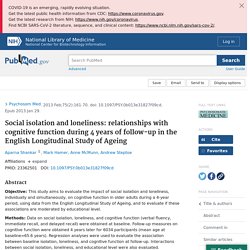
Methods: Data on social isolation, loneliness, and cognitive function (verbal fluency, immediate recall, and delayed recall) were obtained at baseline. Follow-up measures on cognitive function were obtained 4 years later for 6034 participants (mean age at baseline=65.6 years). Regression analyses were used to evaluate the association between baseline isolation, loneliness, and cognitive function at follow-up. How social isolation affects the brain. Daisy Fancourt was at her home in Surrey in southeast England when the UK government formally announced a nationwide lockdown.
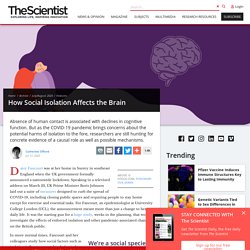
Speaking in a televised address on March 23, UK Prime Minister Boris Johnson laid out a suite of measures designed to curb the spread of COVID-19, including closing public spaces and requiring people to stay home except for exercise and essential tasks. For Fancourt, an epidemiologist at University College London (UCL), the announcement meant more than just a change to her daily life. It was the starting gun for a huge study, weeks in the planning, that would investigate the effects of enforced isolation and other pandemic-associated changes on the British public.
We’re a social species. Effect of social isolation on our brain. The loneliness of social isolation can affect your brain and raise dementia risk in older adults. Physical pain is unpleasant, yet it’s vital for survival because it’s a warning that your body is in danger.
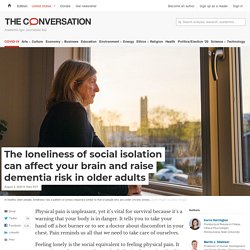
It tells you to take your hand off a hot burner or to see a doctor about discomfort in your chest. Pain reminds us all that we need to take care of ourselves. Feeling lonely is the social equivalent to feeling physical pain. It even triggers the same pathways in the brain that are involved in processing emotional responses to physical pain. Just like feeling physical pain, feeling lonely and disconnected from others is also a signal that we need to take care of ourselves by seeking the safety and comfort of companionship.
As scholars at the Center for Healthy Aging at Penn State, we study the impact of stress on the aging body and brain, including how it can worsen cognitive decline and risk for dementia. The health consequences of loneliness The COVID-19 pandemic has put many older adults’ social lives on hold, leaving them at greater risk for loneliness. Infographic: Symptoms of Alzheimer's disease. Video: Understanding depression & anxiety. Infographic: Symptoms of depression in elderly. Elderly's development: Ageing process and physiological changes. 1.
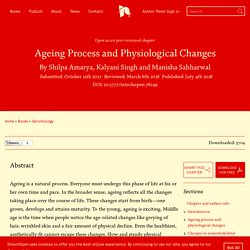
Introduction The term ‘Elderly’ is applied to those individuals belonging to age 60 years and above, who represent the fastest growing segment of populations throughout the world. The percentage of elderly in developing countries tends to be small, although numbers are often large. In the year 1990, there were more than 280 million people belonging to the age 60 years or over in developing regions of the world, and 58% of the world’s elderly were living in less-developed regions [1]. According to World Population Prospects (1950–2050), the proportion of elderly in developing countries is rising more rapidly, in comparison with developed ones [2]. It is expected that by the year 2020, 70% of the world’s elderly population will be in developing countries, with the absolute number exceeding 470 million which is double the number of the developed world [5]. 2. 2.1. Alzheimer’s and Parkinson’s diseases are the progressive neurodegenerative diseases associated with ageing [9]. 2.2. 2.3. 3.
Ageing: Elderly's development, late adulthood. Physical Development in Late Adulthood The aging process often results in a loss of memory, deteriorated intellectual function, decreased mobility, and higher rates of disease.
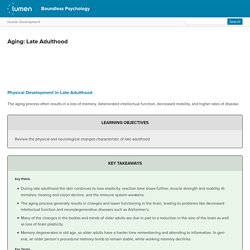
Learning Objectives Review the physical and neurological changes characteristic of late adulthood Key Takeaways Key Points During late adulthood the skin continues to lose elasticity, reaction time slows further, muscle strength and mobility diminishes, hearing and vision decline, and the immune system weakens.The aging process generally results in changes and lower functioning in the brain, leading to problems like decreased intellectual function and neurodegenerative diseases such as Alzheimer’s.Many of the changes in the bodies and minds of older adults are due in part to a reduction in the size of the brain as well as loss of brain plasticity.Memory degenerates in old age, so older adults have a harder time remembering and attending to information. Key Terms. Effect of social isolation on elderly's development. What can caregivers do to prevent social isolation among elderly?
Infographic: Ways of preventing social isolation among elderly. Video: How to keep seniors connected? What can caregivers do for socially isolated elderly? Infographic: How to help elderly in social isolation? Caregivers risk to social isolation. Causes, impacts and strategies of caregiver isolation and loneliness. Ways to overcome or avoid social isolation for caregivers. There's a difference between isolation and loneliness.

Social isolation is the physical separation from other people--a literal lack of social connections or interactions. Meanwhile, loneliness is an emotional response to social isolation--the discrepancy between a person's desired and actual social relationships. In other words, loneliness is the subjective distressed feeling of being alone or separated, while isolation is objective. You can live alone without being lonely, but it is also possible to feel lonely, even when surrounded by people. You may have sacrificed more than you realize to care for a loved one. Caregiver isolation and subsequent loneliness are caused by a lack of social interaction and stimulation due to a withdrawal from previous habits and lifestyle. Recognizing the problem is the first step toward solving it. Maintain Relationships In addition to physical presence, humans need relationships that provide mutual value and trust.
Join a Support Group Ask for Help. Self-care tips for caregivers. Conclusion. Summary: To combat social isolation. Infographic: Caregiver stress & what you can do?